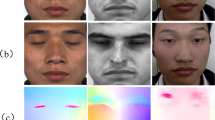Abstract
Regarded as its subtlety, micro-expression is a challenging research problem. In the paper, we propose a relax K-SVD classifier (RK-SVD) for micro-expression recognition. RK-SVD minimizes the variance of sparse coefficients to address the similarity of same classes and the distinctiveness of different classes in sparse coefficients. In addition, reconstruction error and classification error are also considered. The optimization is implemented by the K-SVD algorithm and stochastic gradient descent algorithm. Finally a single overcomplete dictionary and an optimal linear classifier are learned simultaneously. We show that RK-SVD can effectively recognize micro-expression under three spontaneous micro-expression datasets including SMIC, CASME, and CASME II.

Similar content being viewed by others
Explore related subjects
Discover the latest articles, news and stories from top researchers in related subjects.References
Frank MG, Herbasz M, Sinuk AKK, Nolan C (2009) I see how you feel: training laypeople and professionals to recognize fleeting emotions. In the annual meeting of the International Communication Association, New York
OSullivan M, Frank M, Hurley C, Tiwana J (2009) Police lie detection accuracy: the effect of lie scenario. Law Hum Behav 33(6):530–538
Frank M, Maccario C, Govindaraju V (2009) Behavior and security. Greenwood Pub Group, Santa Barbara, California, pp 86–106
Haggard EA, Isaacs KS (1966) Micromomentary facial expressions as indicators of ego mechanisms in psychotherapy. In: Methods of Research in Psychotherapy. Springer, pp 154–165
Ekman P, Friesen WV (1969) Nonverbal leakage and clues to deception. Tech. Rep, DTIC Document
Li X, Pfister T, Huang X, Zhao G, Pietikainen M (2013) A spontaneous microexpression database: inducement, collection and baseline. In: 10th IEEE International Conference and Workshops on Automatic Face and Gesture Recognition (FG), pp 1–6
Yan WJ, Wu Q, Liu YJ, Wang SJ, Fu X (2013) CASME database: a dataset of spontaneous micro-expressions collected from neutralized faces. In: 10th IEEE International Conference and Workshops on Automatic Face and Gesture Recognition (FG), pp 1–7
Yan WJ, Li X, Wang SJ, Zhao G, Liu YJ, Chen YH, Fu X (2014) CASME II: an improved spontaneous micro-expression database and the baseline evaluation. PloS One 9(1):e86041
Xie L, Wei H, Tao D (2016) Multi-view exclusive unsupervised dimension reduction for video-based facial expression recognition. IJCAI-16
Gu B, Sheng V (2016) A robust regularization path algorithm for -support vector classification. IEEE Trans Neural Netw Learn Syst. doi:10.1109/TNNLS.2016.2527796
Gu B, Sheng V, Tay K, Romano W, Li S (2015) Incremental support vector learning for ordinal regression. IEEE Trans Neural Netw Learn Syst 26(7):1403–1416
Wang Y, See J, Phan RC-W, Oh Y-H (2015) Efficient spatio-temporal local binary patterns for spontaneous facial micro-expression recognition. PLoS One 10(5):e0124674
Polikovsky S, Kameda Y, Ohta Y (2009) Facial micro-expressions recognition using high speed camera and 3D-gradient descriptor. In: 3rd International Conference on Crime Detection and Prevention. IET, pp 1–6
Wang SJ, Chen HL, Yan WJ, Chen YH, Fu X (2013) Face recognition and micro-expression based on discriminant tensor subspace analysis plus extreme learning machine. Neural Process Lett
Pfister T, Li X, Zhao G, Pietikainen M (2011) Recognising spontaneous facial micro-expressions. In: 12th IEEE International Conference on Computer Vision, pp 1449–1456
Zhang Q, Li BX (2010) Discriminative k-svd for dictionary learning in face recognition. In: Proceedings of the Computer Vision and Pattern Recognition (CVPR)
Bradley D, Bagnell J (2008) Differential sparse coding. In: Proc. Conf, Neural Information Processing Systems
Mairal J, Bach F, Ponce J (2012) Task-driven dictionary learning. IEEE Trans Patt Anal Mach Intell 34(4):791–804
Chaudhry R, Ravichandran A, Hager G, Vidal R (2009) Histograms of oriented optical flow and binet-cauchy kernels on nonlinear dynamical systems for the recognition of human actions. In: 2009 Conference on Computer Vision and Pattern Recognition (CVPR), pp 1932–1939
Chang CC, Lin CJ (2011) Libsvm: a library for support vector machines. ACM Trans Intell Syst Technol 2(3):1–27
Varma M, Ray D (2007) Learning the discriminative power invariance trade-off. In: ICCV, pp 1–8
Breiman L (2001) Random forests. Mach Learn 45(1):5–32
Acknowledgements
This work is partially supported by the Project funded by China Postdoctoral Science Foundation Under Grant No. 2014M5615556, supported by the National Science Foundation of China (61273300, 61232007) and Jiangsu Natural Science Funds for Distinguished Young Scholar (BK20140022). And, it is also partially supported by Grants 15KJB520024 from Jiangsu University Natural Science Funds, supported by Grants KFKT2014B18 from the State Key Laboratory for Novel Software Technology from Nanjing University, supported by the Collaborative Innovation Center of Wireless Communications Technology, Grants 2015NXY05 from Nanjing Xiaozhuang University. Finally, the authors would like to thank the anonymous reviewers for their constructive advice.
Author information
Authors and Affiliations
Corresponding author
Rights and permissions
About this article
Cite this article
Zheng, H., Zhu, J., Yang, Z. et al. Effective micro-expression recognition using relaxed K-SVD algorithm. Int. J. Mach. Learn. & Cyber. 8, 2043–2049 (2017). https://doi.org/10.1007/s13042-017-0684-6
Received:
Accepted:
Published:
Issue Date:
DOI: https://doi.org/10.1007/s13042-017-0684-6




